Let me tell you about my absolute favorite take on Filipino Beef Curry. I first fell in love with curry during a trip to Thailand .But something was missing: that distinct Pinoy touch that makes everything taste like home.
After countless experimenting in my kitchen (and making my neighbors jealous with the aroma), I've perfected this Filipino-style beef curry that even my aunts now request during family gatherings.
Using tender beef chuck, creamy gata and our signature blend of spices, this curry hits differently. It's milder than Thai curry but packed with familiar Filipino flavors that remind you of weekend family lunches.
It's actually easier to make than it looks, and I'll share all my practical tips to help you nail it on your first try.
Jump to:
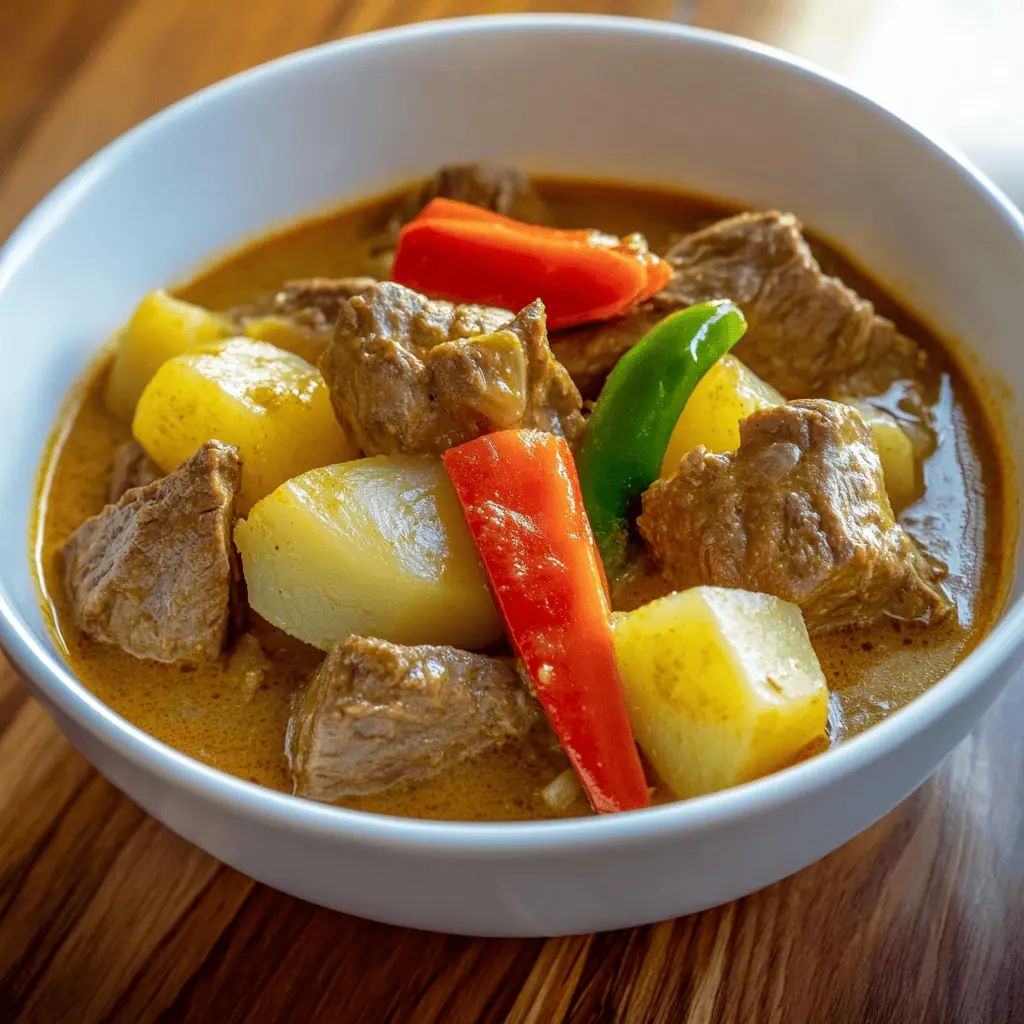
Why You'll Love This Recipe
- Melt-in-Your-Mouth Tender: Our special technique ensures perfectly tender beef every time
- Rich, Complex Flavors: Balanced blend of curry spices and coconut milk
- Make-Ahead Friendly: Tastes even better the next day
- One-Pot Wonder: Less cleanup, maximum flavor
- Family-Approved: Kid-friendly level of spice that can be adjusted
- Budget-Friendly: Uses affordable cuts of beef
- Freezer-Friendly: Perfect for batch cooking
Ingredients
The ingredients in this Filipino Beef Curry create a perfect harmony of flavors and textures. Chuck roast provides rich, tender meat that becomes succulent after slow cooking. Potatoes and carrots add hearty substance while absorbing the curry flavors.
The aromatic base of garlic, ginger, and onions creates depth, while bell peppers add bright color and fresh crunch. Coconut milk delivers creamy richness that balances the savory curry powder, while fish sauce adds that crucial umami depth.
This thoughtful combination creates a curry that's milder than Thai or Indian versions but still complex, showcasing the Filipino talent for adapting international dishes with a distinctly homey, comforting touch that appeals to the whole family.
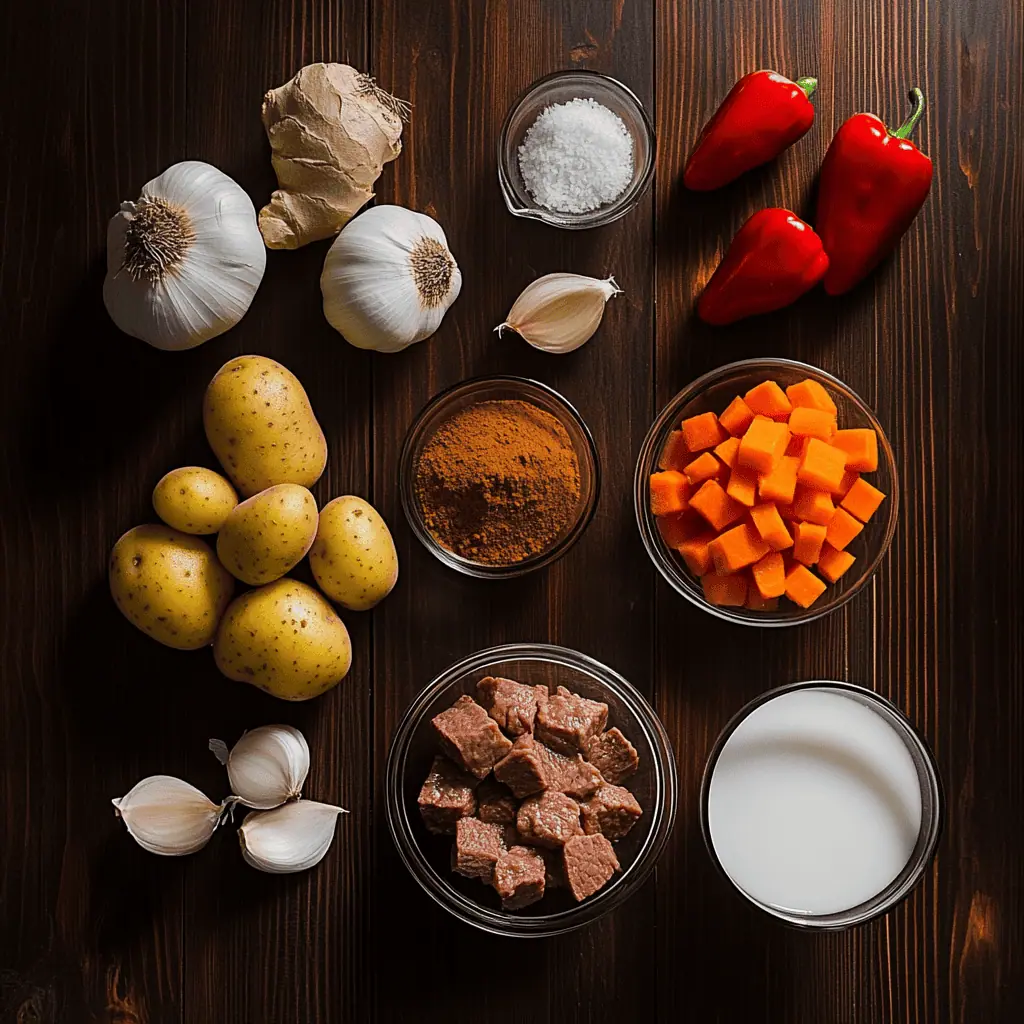
For the Meat and Vegetables
- 3 pounds beef chuck roast, cut into 2-inch cubes
- 2 medium potatoes (patatas), peeled and cubed
- 2 large carrots, peeled and cubed
- 1 large onion (sibuyas), chopped
- 4 cloves garlic (bawang), minced
- 1 thumb-size ginger (luya), julienned
- ½ red bell pepper
- ½ green bell pepper
For the Sauce
- 1 can (13.5 oz) coconut milk (gata)
- 2 tablespoons curry powder
- 1 tablespoon fish sauce (patis)
- 2 cups water (tubig)
- ¼ cup cooking oil (mantika)
- Salt and pepper (asin at paminta)
Equipment
- Heavy-bottomed Dutch oven or pot: Essential for even heat distribution and preventing scorching during the long simmering process. The heavy bottom ensures the curry cooks evenly without burning.
- Sharp chef's knife: For cutting the beef into uniform pieces that will cook consistently.
- Cutting board: Preferably with a juice groove to catch any liquids from the meat and vegetables.
- Wooden spoon or silicone spatula: For stirring without scratching your pot and scraping up the flavorful fond from the bottom.
- Measuring cups and spoons: For accurate measurements of ingredients.
- Meat thermometer: To ensure beef is cooked to the proper temperature (195°F/90°C for tender chuck).
- Timer: To keep track of simmering times for perfect meat tenderness.
- Ladle: For serving the curry without making a mess.
- Airtight containers: For storing leftovers properly.
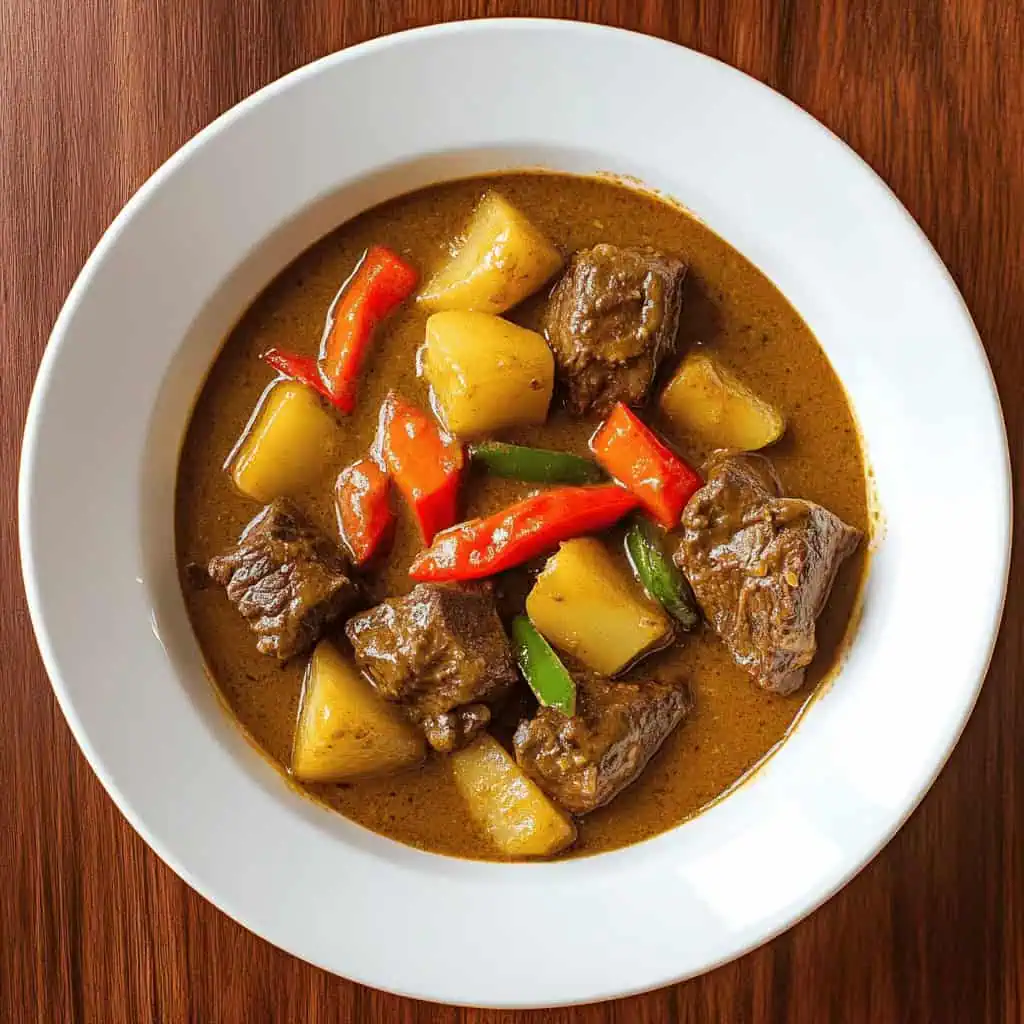
How To Make
- Prepare your ingredients. Take your beef chuck roast out of the refrigerator 30 minutes before cooking to reach room temperature. While waiting, peel and cut your potatoes and carrots into uniform 2-inch cubes. Clean your bell peppers and slice them into strips. Finely chop the onions and garlic, then julienne the ginger. This preparation ensures smooth cooking later.
- Prepare the beef. Pat your beef dry with paper towels and cut it into uniform 2-inch cubes. Season the meat generously with salt and black pepper. Having uniform sizes ensures even cooking.
- Sear the beef. Place a heavy-bottomed pot or dutch oven over medium-high heat (375°F). Add your cooking oil and let it heat until shimmering. Working in small batches to avoid overcrowding, sear the beef chunks until they develop a golden-brown crust on all sides, about 3-4 minutes per side. Remove the browned meat and set aside on a plate.
- Create the flavor base. Lower the heat to medium (325°F) and in the same pot, add your chopped onions. Cook them until they become translucent and soft, about 3-4 minutes. Add your minced garlic and julienned ginger, cooking for another 1-2 minutes until fragrant. Add your curry powder and toast it briefly for 30 seconds to release its essential oils and deepen the flavor.
- Simmer the beef. Return the seared beef to the pot and pour in the water and fish sauce. Bring the mixture to a gentle boil, then reduce the heat to low (300°F). Cover the pot and let it simmer for approximately 1.5 hours, or until the meat becomes tender enough to easily pierce with a fork.
- Add coconut milk. Once the meat is tender, pour in your coconut milk. Stir gently and bring the curry back to a simmer uncovered. Cook for 15 minutes, allowing the sauce to thicken slightly.
- Cook the vegetables. Add your cubed potatoes and carrots to the pot. Let them cook in the curry sauce for 10 minutes or until they're tender but still hold their shape. In the last 5 minutes of cooking, add your sliced bell peppers. This keeps them crisp and colorful.
- Season to taste. Taste your curry and adjust the seasoning with additional salt, pepper, or fish sauce according to your preference. The sauce should be rich and creamy, coating the back of a spoon.
- Rest before serving. Let the curry rest for 5-10 minutes before serving to allow the flavors to settle. During this time, the sauce will continue to thicken slightly and the flavors will develop further.
- Serve. Serve your Filipino Beef Curry hot over steamed rice.

Tips from Lola's Kitchen
- Secret to tender meat: Before cooking, pierce your beef chunks with a fork all over. This helps the marinade penetrate deeper and creates channels for the curry flavor to infuse.
- For maximum flavor development: Marinate the beef overnight in a mixture of minced garlic, salt, pepper, and a splash of calamansi juice. This not only tenderizes but adds a subtle citrus note to the final dish.
- Prevent coconut milk from curdling: Always use room temperature coconut milk and add it toward the end of cooking. Stir it in gradually and never let it reach a rolling boil.
- Enhance the curry flavor: Toast your curry powder in a dry pan for 30 seconds before adding it to the dish. This activates the essential oils in the spices and creates a deeper, more complex flavor profile.
- Perfect vegetable texture: Cut all vegetables into similar sizes for even cooking. Add harder vegetables (potatoes, carrots) earlier and softer ones (bell peppers) in the last few minutes.
- For a lighter dish: After simmering the meat, let the pot cool slightly and skim off excess oil that rises to the surface. This creates a cleaner flavor without sacrificing richness.
- Develop deep flavors: Let the curry rest overnight in the refrigerator if possible. The flavors will meld together beautifully, creating an even more delicious dish the next day.
- Perfect the sauce consistency: If your sauce is too thin after adding vegetables, remove the lid and simmer for 5-10 minutes. For an extra-thick sauce, mash some of the cooked potatoes against the side of the pot.
Substitutions
- Beef: If beef chuck isn't available, use beef brisket or short ribs for equally tender results. For a lighter version, substitute with chicken thighs (reduce cooking time to 45 minutes) or goat meat (increase cooking time by 30 minutes).
- Coconut milk: If you're out of coconut milk, combine 1 cup heavy cream with 1 teaspoon coconut extract. For a lighter option, use light coconut milk mixed with 1 tablespoon of cornstarch.
- Fish sauce: Substitute with 1 tablespoon Worcestershire sauce mixed with ½ teaspoon salt, or use 1 tablespoon soy sauce with a squeeze of lime juice for a similar umami effect.
- Fresh ginger: Replace with 1 teaspoon ground ginger in a pinch, though the flavor will be less vibrant. Alternatively, use 2 teaspoons of galangal for a more authentic Southeast Asian flavor.
- Bell peppers: Green beans, snap peas, or sliced eggplant can work well as alternatives. Each will absorb the curry flavor differently but provide nice textural contrast.
- Curry powder: Make your own blend with 1 tablespoon turmeric, 1 teaspoon cumin, 1 teaspoon coriander, ½ teaspoon ginger powder, and ¼ teaspoon cinnamon.
- Potatoes: For a lower-carb version, substitute with cauliflower florets, turnips, or radishes. Add these in the last 15 minutes of cooking to prevent overcooking.
Troubleshooting
- Tough Meat
- Issue: Beef remains tough even after long cooking
- Solution: Cut meat against the grain next time. For this batch, continue simmering on low heat for another 30-45 minutes. If still tough, shred the meat and return to the sauce – it will appear intentionally shredded rather than undercooked.
- Curry Too Thin
- Issue: Sauce isn't thick enough
- Solution: Simmer uncovered for 10-15 minutes to reduce. Alternatively, mix 1 tablespoon cornstarch with 2 tablespoons cold water and stir into the simmering curry. For a traditional approach, mash some of the cooked potatoes and stir them back in.
- Sauce Separated
- Issue: Coconut milk has curdled or separated
- Solution: Lower heat immediately and whisk gently to recombine. Add 1-2 tablespoons of room temperature coconut milk while stirring. In the future, ensure you're using full-fat coconut milk and adding it at a lower temperature.
- Not Yellow Enough
- Issue: Curry lacks the vibrant golden color
- Solution: Add ½ teaspoon ground turmeric and simmer for 5 more minutes. Next time, ensure your curry powder is fresh and toasted properly before adding other ingredients.
- Too Spicy
- Issue: Curry is too hot for your taste
- Solution: Add an extra ½ cup coconut milk to dilute the heat. A teaspoon of sugar can also help balance spiciness. Serve with extra rice or a side of cucumber salad to cool the palate.
- Vegetables Overcooked
- Issue: Vegetables are too soft or mushy
- Solution: Unfortunately, you can't un-cook vegetables. For this batch, mash some to thicken the sauce and position firmer pieces on top when serving. Next time, add vegetables in stages based on cooking time needs.
Storage & Reheating
- Refrigerator Storage: Store in an airtight container for 3-4 days. The flavors will actually improve after 24 hours, making this an excellent make-ahead dish.
- Freezer Storage: Freeze in portion-sized containers for up to 3 months. For best results, slightly undercook the vegetables before freezing. Note that potatoes may change texture when frozen, so consider omitting them if you plan to freeze a large batch.
- Thawing: Thaw overnight in the refrigerator for best results. If you're in a hurry, use the defrost setting on your microwave, stirring occasionally to ensure even thawing.
- Stovetop Reheating: The preferred method. Heat over medium-low heat, stirring occasionally and adding 2-3 tablespoons of water or coconut milk if the sauce has thickened too much. Heat until internal temperature reaches 165°F (74°C).
- Microwave Reheating: Place in a microwave-safe container, add 1-2 tablespoons of water, cover loosely, and heat on 70% power for 2-3 minutes. Stir halfway through for even heating.
- Meal Prep Tip: Cook a double batch and portion into meal-prep containers with steamed rice for easy lunches throughout the week.
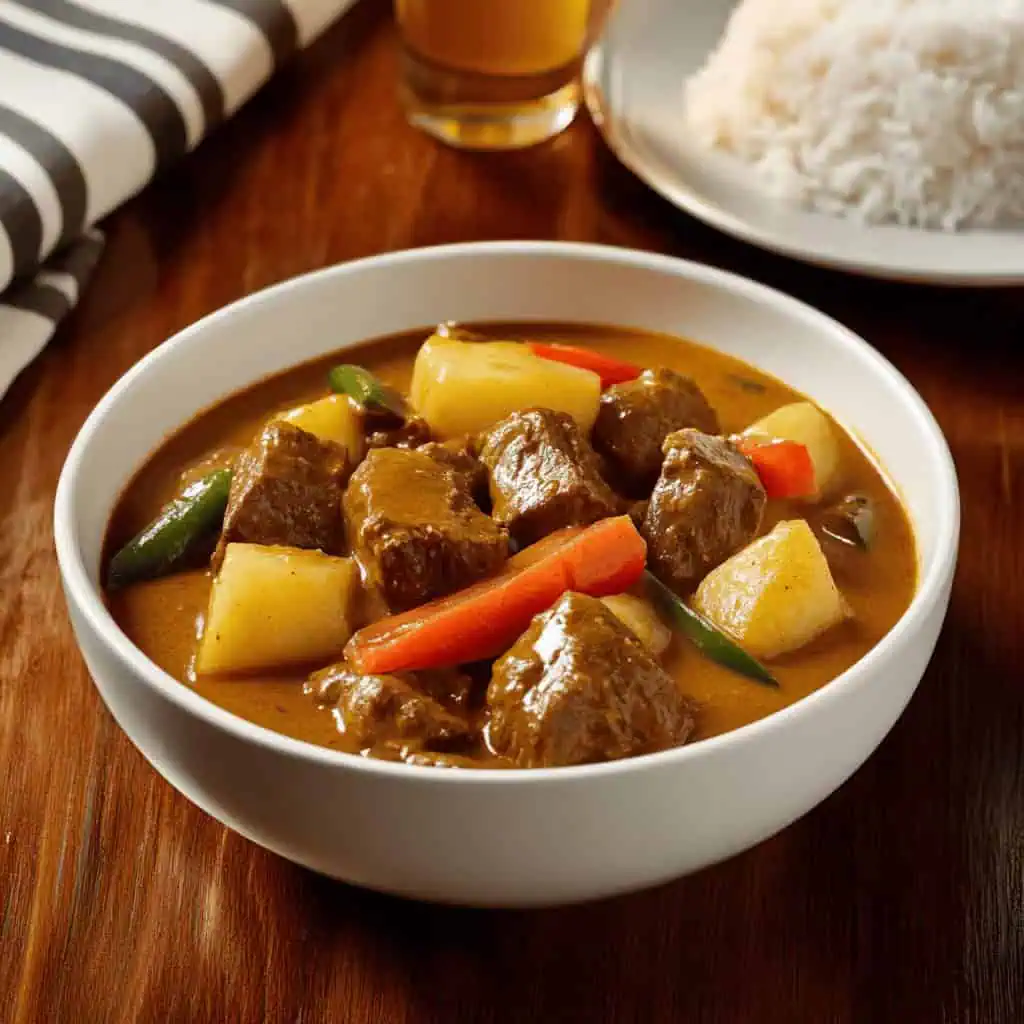
FAQ
Can I make this in a slow cooker?
Absolutely! First, sear the meat and sauté the aromatics as directed, then transfer to a slow cooker. Cook on low for 8 hours or high for 4 hours. Add the vegetables and coconut milk during the last hour of cooking for best results.
Why isn't my curry yellow enough?
The quality and freshness of curry powder significantly affects color. Make sure to use fresh curry powder and consider adding ½ teaspoon of turmeric for a more vibrant yellow color. Toasting the curry powder before adding liquid also intensifies both color and flavor.
Can I use light coconut milk?
While possible, it's not recommended as it affects both texture and flavor. Light coconut milk contains more water and less fat, resulting in a thinner sauce that lacks the rich mouthfeel that makes this curry special. If calories are a concern, use full-fat coconut milk but in a slightly smaller quantity.
How spicy is this curry?
This recipe creates a mild-medium curry that's family-friendly. To increase heat, add 1-2 chopped Thai bird's eye chilies with the garlic and ginger, or incorporate ¼-½ teaspoon cayenne pepper when adding the curry powder. For a milder version, reduce the curry powder to 1 tablespoon.
Can I make it ahead for a party?
Yes, and it's actually recommended! The flavor improves after resting overnight in the refrigerator. Make it 1-2 days ahead, refrigerate, and reheat gently on the stove before serving. If the sauce thickens too much, add a splash of coconut milk or water when reheating.
Why did my potatoes turn to mush?
This happens when potatoes cook too long. Add potatoes only after the meat is tender, and use waxy potatoes (like Yukon Gold or red potatoes) rather than starchy varieties like Russets, which break down more easily.
Can I use beef stew meat instead of chuck roast?
While pre-packaged stew meat is convenient, it often contains mixed cuts with varying tenderness. For consistent results, buy chuck roast and cut it yourself. If you do use stew meat, be prepared to adjust cooking time as some pieces may become tender before others.
How do I know when the beef is properly tender?
The beef should easily pull apart with a fork but still hold its shape. If you have a meat thermometer, the internal temperature should reach around 195°F (90°C) for chuck roast to break down its collagen properly
Related
Looking for other recipes like this? Try these:
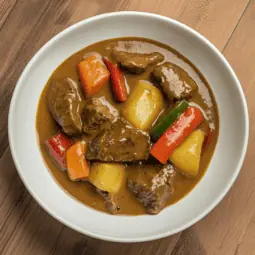
Filipino Beef Curry
Ingredients
For the Meat and Vegetables
- 3 pounds beef chuck roast karneng baka, cut into 2-inch cubes
- 2 medium potatoes patatas, peeled and cubed
- 2 large carrots peeled and cubed
- 1 large onion sibuyas, chopped
- 4 cloves garlic bawang, minced
- 1 thumb-size ginger luya, julienned
- ½ red bell pepper pulang siling pangsigang
- ½ green bell pepper berdeng siling pangsigang
For the Sauce
- 1 can 13.5 oz coconut milk (gata)
- 2 tablespoons curry powder pulbos ng curry
- 1 tablespoon fish sauce patis
- 2 cups water tubig
- ¼ cup cooking oil mantika
- Salt and pepper asin at paminta
Instructions
- Begin by preparing your ingredients. Take your beef chuck roast (karneng baka) out of the refrigerator 30 minutes before cooking to reach room temperature. While waiting, peel and cut your potatoes (patatas) and carrots into uniform 2-inch cubes. Clean your bell peppers (siling pangsigang) and slice them into strips. Finely chop the onions (sibuyas) and garlic (bawang), then julienne the ginger (luya). This preparation (paghahanda) ensures smooth cooking later.
- Pat your beef dry with paper towels and cut it into uniform 2-inch cubes. Season the meat generously with salt (asin) and black pepper (paminta). Having uniform sizes ensures even cooking (pantay na pagluluto).
- Place a heavy-bottomed pot or dutch oven over medium-high heat (190°C/375°F). Add your cooking oil (mantika) and let it heat until shimmering. Working in small batches to avoid overcrowding, sear the beef chunks until they develop a golden-brown crust on all sides, about 3-4 minutes per side. Remove the browned meat and set aside on a plate.
- Lower the heat to medium (165°C/325°F) and in the same pot, add your chopped onions. Cook them until they become translucent and soft (malinaw at malambot), about 3-4 minutes. Add your minced garlic and julienned ginger, cooking for another 1-2 minutes until fragrant (mabango). Add your curry powder and toast it briefly for 30 seconds to release its essential oils and deepen the flavor (paramasarap).
- Return the seared beef to the pot and pour in the water (tubig) and fish sauce (patis). Bring the mixture to a gentle boil, then reduce the heat to low (150°C/300°F). Cover the pot and let it simmer for approximately 1.5 hours, or until the meat becomes tender enough to easily pierce with a fork (malambot na malambot).
- Once the meat is tender, pour in your coconut milk (gata). Stir gently and bring the curry back to a simmer uncovered. Cook for 15 minutes, allowing the sauce to thicken slightly (lumapot ng konti).
- Add your cubed potatoes and carrots to the pot. Let them cook in the curry sauce for 10 minutes or until they're tender but still hold their shape (malambot pero hindi lulusaw). In the last 5 minutes of cooking, add your sliced bell peppers. This keeps them crisp and colorful (malutong at makulay).
- Taste your curry and adjust the seasoning with additional salt, pepper, or fish sauce according to your preference (ayon sa panlasa). The sauce should be rich and creamy, coating the back of a spoon (malapot at malinamnam).
- Let the curry rest for 5-10 minutes before serving to allow the flavors to settle. During this time, the sauce will continue to thicken slightly and the flavors will develop further.
- Serve your Filipino Beef Curry hot over steamed rice (mainit na kanin). Store any leftovers in an airtight container in the refrigerator for up to 3-4 days. When reheating, do so gently over medium-low heat (165°C/325°F), adding a splash of water if needed to maintain the sauce's consistency. You may also freeze portions for up to 3 months.
- Remember that this curry often tastes even better the next day, as the flavors have more time to meld together (mas lalasa pa kinabukasan). When reheating, always ensure the curry is heated thoroughly to 165°F (74°C) for food safety.
Tips from Lola's Kitchen
- Marinate beef overnight for maximum flavor
- Use room temperature coconut milk to prevent curdling
- Toast curry powder to release essential oils
- Cut vegetables in similar sizes for even cooking
- Skim off excess oil for a lighter dish
- Let meat rest 5 minutes after searing
- Add coconut milk at the end to prevent splitting
Nutrition
The Story Behind Filipino Beef Curry
Growing up in a Filipino household, I've always been fascinated by how we Pinoys can transform any international dish into something uniquely our own. Filipino Beef Curry (Kare-Kare na Baka) is perhaps one of the most beautiful examples of this culinary adaptation, showing how our local flavors dance perfectly with foreign influences.
The journey of curry to Filipino kitchens tells a fascinating story of trade and cultural exchange. While Indian and Thai curries have existed for centuries, our version emerged through Southeast Asian trade routes, particularly during the increased cultural exchange of the 1960s and 1970s. Unlike its spicier Thai or Indian counterparts, Filipino curry evolved to suit our local palate, incorporating our love for creamy coconut milk (gata) and a milder, sweeter curry profile that feels distinctly Pinoy.
What makes our Filipino Beef Curry special is how it embraces local ingredients and cooking techniques. We use chunks of beef chuck (karneng baka) slowly simmered until tender - a cooking method similar to our beloved mechado or kaldereta. The addition of potatoes and carrots isn't just for flavor; it's a practical way Filipino mothers stretched the dish to feed large families, a practice we've long used in our traditional stews.
The genius of Filipino-style curry lies in its adaptability. Each region has its own twist - some families in Bicol add siling labuyo for heat, while some households in Manila secretly add evaporated milk or cheese for extra richness. In Mindanao, where coconut milk is abundant, the curry sauce becomes extraordinarily creamy and rich. These regional variations show how deeply this adopted dish has rooted itself in Filipino cuisine.
Today, Filipino Beef Curry has become a modern classic, often served at special occasions and family gatherings. It's a dish that perfectly represents our culture's ability to adapt and improve upon foreign influences, creating something that's both globally inspired and unmistakably Filipino. Whether you're cooking it for a simple family dinner or a special celebration, this curry dish carries with it the warmth and creativity of Filipino kitchens.
Remember: Perfect Filipino beef curry isn't about authenticity to other curry traditions—it's about achieving that perfect balance of mild curry flavor, creamy coconut milk, and tender beef that makes it uniquely and deliciously Filipino.
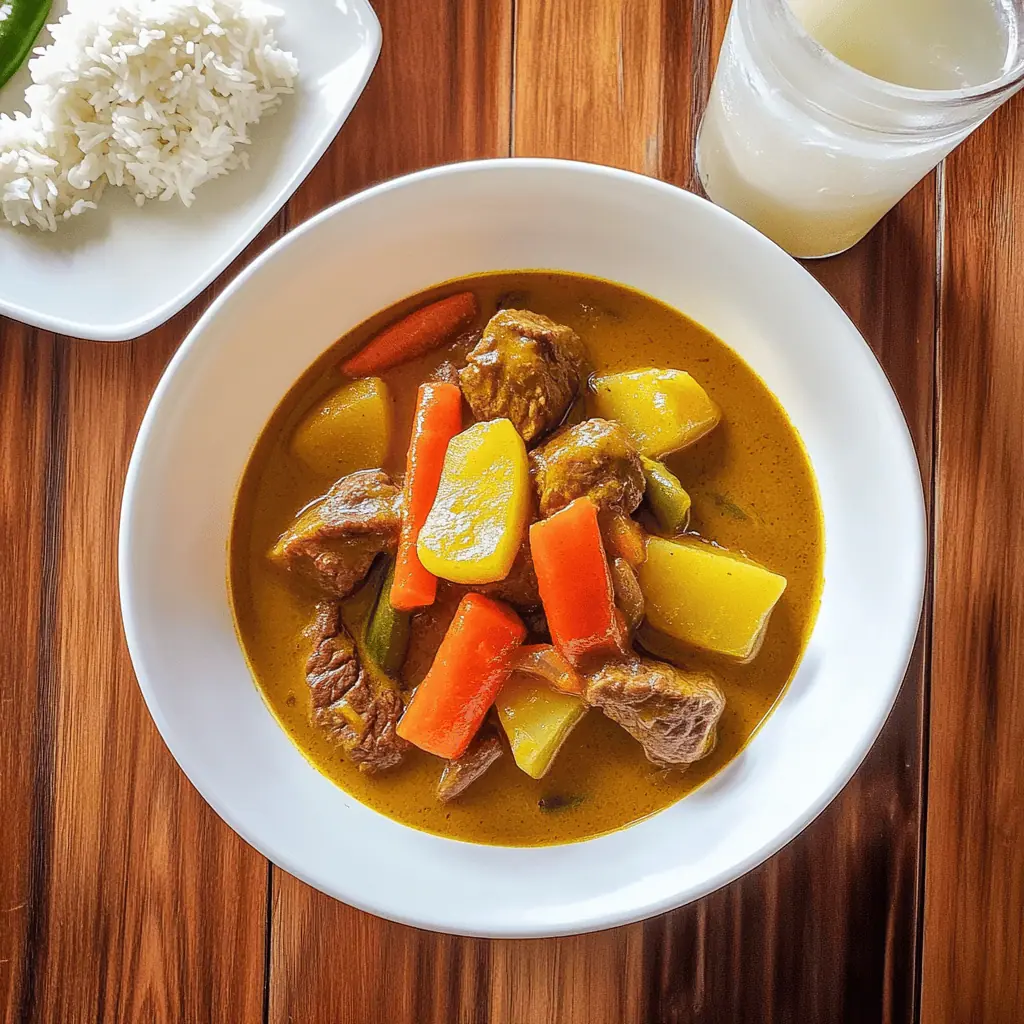









Comments
No Comments